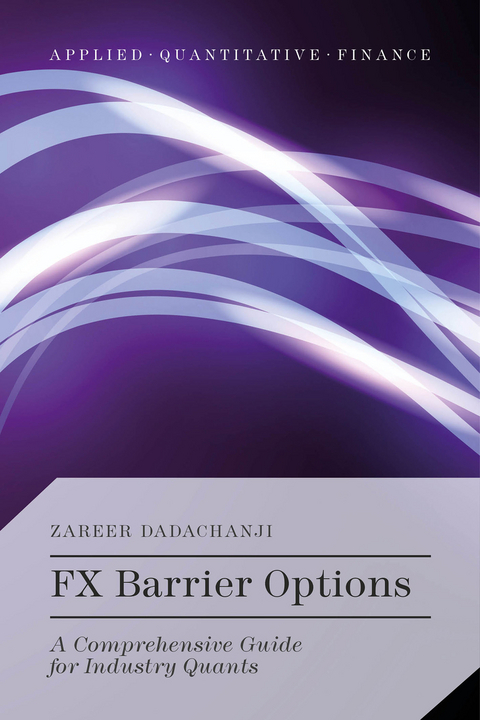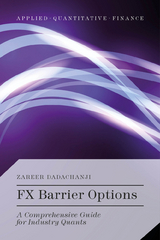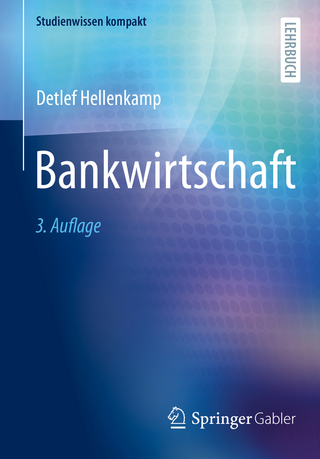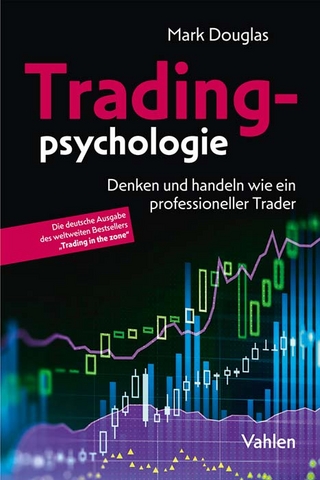FX Barrier Options
Palgrave Macmillan (Verlag)
978-1-137-46274-9 (ISBN)
FX structured products commonly include barrier features, and in order to analyse the effects that these features have on the overall structured product, it is essential first to understand how individual barrier options work and behave.
FX Barrier Options takes a quantitative approach to barrier options in FX environments. Its primary perspectives are those of quantitative analysts, both in the front office and in control functions. It presents and explains concepts in a highly intuitive manner throughout, to allow quantitatively minded traders, structurers, marketers, salespeople and software engineers to acquire a more rigorous analytical understanding of these products.
The book derives, demonstrates and analyses a wide range of models, modelling techniques and numerical algorithms that can be used for constructing valuation models and risk-management methods. Discussions focus on the practical realities of the market and demonstrate the behaviour of models based on real and recent market data across a range of currency pairs. It furthermore offers a clear description of the history and evolution of the different types of barrier options, and elucidates a great deal of industry nomenclature and jargon.
Zareer Dadachanji is a quantitative analysis consultant with nearly two decades of corporate experience, mostly in financial quantitative modelling across a range of asset classes. He has spent 14 years working as a front-office quant at banks and hedge funds, including NatWest/RBS, Credit Suisse and latterly Standard Chartered Bank, where he held the position of Global Head of FX Quants. Zareer's specialist areas of expertise are the modelling of FX and equity derivatives. He combines these specialist areas with substantial knowledge of general quantitative modelling, gained through years of senior-level engagement in the activities of global cross-asset quant teams. Zareer is the founder and director of Model Quant Solutions, an independent consultancy providing bespoke quantitative analysis and training on a range of financial subjects. The consultancy serves a variety of clients and client types across the finance industry. Zareer holds a triple first in Natural Sciences and a PhD in Computational and Theoretical Physics, both from the University of Cambridge.
Preface Foreword Glossary of Mathematical Notation Contract Types 1 Meet the Products 1.1 Spot 1.1.1 Dollars per euro or euros per dollar? 1.1.2 Big figures and small figures 1.1.3 The value of Foreign 1.1.4 Converting between Domestic and Foreign 1.2 Forwards 1.2.1 The FX forward market 1.2.2 A formula for the forward rate 1.2.3 Payoff a forward contract 1.2.4 Valuation of a forward contract 1.3 Vanilla options 1.3.1 Put-Call Parity 1.4 Barrier-contingent vanilla options 1.5 Barrier-contingent payments 1.6 Rebates 1.7 Knock-in-knock-out (KIKO) options 1.8 Types of barriers 1.9 Structured products 1.10 Specifying the contract 1.11 Quantitative truisms 1.11.1 Foreign exchange symmetry and inversion 1.11.2 Knock-out plus knock-in equals no-barrier contract 1.11.3 Put-call parity 1.12 Jargon-buster 2 Living in a Black-Scholes World 2.1 The Black-Scholes model equation for spot price 2.2 The process for ln S 2.3 The Black-Scholes equation for option pricing 2.3.1 The lagless approach 2.3.2 Derivation of the Black-Scholes PDE 2.3.3 Black-Scholes model | hedging assumptions 2.3.4 Interpretation of the Black-Scholes PDE 2.4 Solving the Black-Scholes PDE 2.5 Payments 2.6 Forwards 2.7 Vanilla options 2.7.1 Transformation of the Black-Scholes PDE 2.7.2 Solution of the diffusion equation for vanilla options 2.7.3 The vanilla option pricing formulae 2.7.4 Price quotation styles 2.7.5 Valuation behaviour 2.8 Black-Scholes pricing of barrier-contingent vanilla options 2.8.1 Knock-outs 2.8.2 Knock-ins 2.8.3 Quotation methods 2.8.4 Valuation behaviour 2.9 Black-Scholes pricing of barrier-contingent payments 2.9.1 Payment in Domestic 2.9.2 Payment in Foreign 2.9.3 Quotation methods 2.9.4 Valuation behaviour 2.10 Discrete barrier options 2.11 Window barrier options 2.12 Black-Scholes numerical valuation methods 3 Black-Scholes Risk Management 3.1 Spot risk 3.1.1 Local spot risk analysis 3.1.2 Delta 3.1.3 Gamma 3.1.4 Results for spot Greeks 3.1.5 Non-local spot risk analysis 3.2 Volatility risk 3.2.1 Local volatility risk analysis 3.2.2 Non-local volatility risk 3.3 Interest rate risk 3.4 Theta 3.5 Barrier over-hedging 3.6 Co-Greeks 4 Smile Pricing 4.1 The shortcomings of the Black-Scholes model 4.2 Black-Scholes with term structure (BSTS) 4.3 The implied volatility surface 4.4 The FX vanilla option market 4.4.1 At-the-money volatility 4.4.2 Risk reversal 4.4.3 Buttery 4.4.4 The role of the Black-Scholes model in the FX vanilla options market 4.5 Theoretical Value (TV) 4.5.1 Conventions for extracting market data for TV calculations 4.5.2 Example broker quote request 4.6 Modelling market implied volatilities 4.7 The probability density function 4.8 Three things we want from a model 4.9 The local volatility (LV) model 4.9.1 It's the smile dynamics, stupid 4.10 Five things we want from a model 4.11 Stochastic volatility (SV) models 4.11.1 SABR model 4.11.2 Heston model 4.12 Mixed local/stochastic volatility (lsv) models 4.12.1 Term structure of volatility of volatility 4.13 Other models and methods 4.13.1 Uncertain Volatility (UV) models 4.13.2 Jump-diffusion models 4.13.3 Vanna-volga methods 5 Smile Risk Management 5.1 Black-Scholes with term structure 5.2 Local volatility model 5.3 Spot risk under smile models 5.4 Theta risk under smile models 5.5 Mixed local/stochastic volatility models 5.6 Static hedging 5.7 Managing risk across businesses 6 Numerical Methods 6.1 Finite-difference (FD) methods 6.1.1 Grid geometry 6.1.2 Finite-difference schemes 6.2 Monte Carlo (MC) methods 6.2.1 Monte Carlo schedules 6.2.2 Monte Carlo algorithms 6.2.3 Variance reduction 6.2.4 The Brownian Bridge 6.2.5 Early termination 6.3 Calculating Greeks 6.3.1 Bumped Greeks 6.3.2 Greeks from finite-difference calculations 6.3.3 Greeks from Monte Carlo 7 Further Topics 7.1 Managed currencies 7.2 Stochastic interest rates (SIR) 7.3 Real-world pricing 7.3.1 Bid-offer spreads 7.3.2 Rules-based pricing methods 7.4 Regulation and market abuse A Derivation of the Black-Scholes Pricing Equations for Vanilla Options B Normal and lognormal probability distributions B.1 Normal distribution B.2 Lognormal distribution C Derivation of the local volatility function C.1 Derivation in terms of call prices C.2 Local volatility from implied volatility C.3 Working in moneyness space C.4 Working in log space C.5 Specialization to BSTS D Calibration of mixed local/stochastic volatility (LSV) models E Derivation of Fokker-Planck equation for the local volatility model
| Erscheint lt. Verlag | 29.9.2015 |
|---|---|
| Reihe/Serie | Applied Quantitative Finance |
| Zusatzinfo | XXIX, 244 p. |
| Verlagsort | Basingstoke |
| Sprache | englisch |
| Maße | 155 x 235 mm |
| Themenwelt | Naturwissenschaften |
| Wirtschaft ► Allgemeines / Lexika | |
| Wirtschaft ► Betriebswirtschaft / Management ► Finanzierung | |
| Betriebswirtschaft / Management ► Spezielle Betriebswirtschaftslehre ► Bankbetriebslehre | |
| ISBN-10 | 1-137-46274-4 / 1137462744 |
| ISBN-13 | 978-1-137-46274-9 / 9781137462749 |
| Zustand | Neuware |
| Haben Sie eine Frage zum Produkt? |
aus dem Bereich




